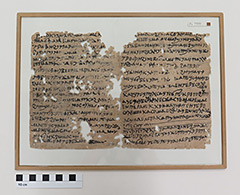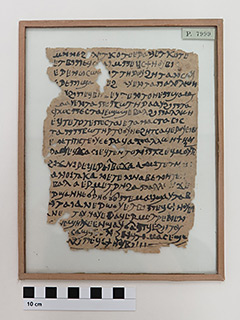|
Material: Papier |
Acquisition: Käufer: Rudolf Mosse |
|
Form: |
Location:
Papyrusdepot |
|
Text Layout: Zeilen: 20; 17; 18; 5 |
Side and Direction:
|
|
Language: Koptisch (Sahidisch) |
Other Side:
|
|
Genre: literarisch |
Script and Notations: flüchtige, unbeholfene Schrift; Buchstabenhöhe: 0,5 cm; Zeilenabstand: 0,3; 0,6 cm; Zeilenlänge: 12,5 cm |
|
Date: 11. Jh. n.Chr. |
Provenance: Umm el-Baragat (Faijûm) |
Content:
Geschichte des Vogels Alloe; ähnliche Schriftstücke stammen aus Dorf Tuton; Skriptorium von Tuton; grobe Zierleiste im oberen Teil des Doppelblattes |
Publication:
A. Erman, Bruchstücke des koptischen Physiologus, ZÄS 33, 1895, 53–57.
Additional Literature:
O. von Lemm, Koptische Miscellen LXXXI; zum koptischen Physiologus, Bulletin de l'Académie Impériale des Sciences de St.-Pétersbourg 4, 1910, 1097–1128; A. van Lantschoot, A propos du Physiologus, Bulletin of the Byzantine Institute of America 2, 1950, 339–363; KOHD Coptica (Pietruschka). |
Catalogs:
|
Notes:
Zwei Fragmente aus einem Pergamentkodex. Beidseitig beschriftet, Fleischseite ist stark abgerieben, löchrig. Beide Fragmente sind untere Teile eines Blattes. Zweikolumnig. Fleischseite ist kaum lesbar. |
|
|






